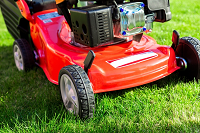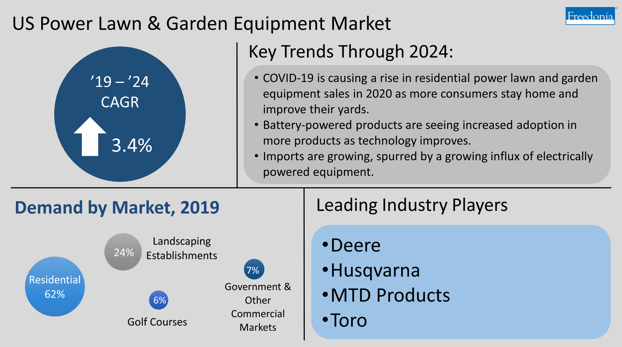Report Overview
13th Edition
Featuring 106 tables and 57 figures – now available in Excel and Powerpoint! Learn More

This study examines the US market for power lawn and garden equipment.
Historical data for 2009, 2014, and 2019 and forecasts for 2024 and 2029 for manufacturers’ shipments, demand, imports, and exports are provided in current dollar terms (which are not adjusted for inflation). Demand is also provided in unit terms. Major power sources, markets, and regional trends are also analyzed. Excluded from the scope of this study is machinery used in agricultural applications. Also excluded are compact utility equipment (e.g., compact utility loaders and skid steers) and other related products that have a primary purpose in construction markets.
Demand is presented by product:
- lawn mowers
- front-engine riding mowers (also called lawn tractors)
- rear-engine riding mowers (including zero turn types)
- walk behind lawn mowers (self-propelled, push)
- robotic lawn mowers
- turf and grounds mowers
- riding mowers (e.g., rotary, reel; including zero turn types)
- walk behind mowers (including robotic lawn mowers)
- stand-on and other specialty mowers (e.g., trimmer mowers)
- tow-behind mowers with dedicated engines
- trimmers and edgers, including:
- wire blade and string trimmers
- trimmer/edger combination productions (whether wire blade or fixed blade)
- fixed blade edgers
- brush cutters (fixed blade)
- garden tractors and rotary tillers, including garden tractors with:
- under 16 horsepower (hp)
- 16 hp to 19.9 hp
- 20 hp and over
- chainsaws
- blowers, vacuums, and sweepers
- snow blowers/snow throwers (single-, dual-, and three-stage)
- other equipment, including:
- compact utility tractors
- hedge trimmers
- turf tracks, turf aerators, turf dethatchers
- multi-tools designed for used with attachments
- cultivators and tillers/cultivators
- pole saws and pruners
- seeders and spreaders
- chippers and shredders
- log splitters and stump grinders
- parts and attachments, including:
- mower blades
- replacement chains for chainsaws
- extra/replacement batteries
- certain tow-behind mowers and tillers
- snow plows and attachment-type snow blowers
- multi-tool attachments
Since the vast majority of engines for power lawn and garden equipment are used in OEM capacities, engines are excluded from the scope of this study, except insofar as they contribute to the value of the equipment that they power. Unpowered lawn mowers are also excluded from the scope of the study
Demand is also segmented by power source:
- internal combustion engine
- corded electric
- battery-powered/cordless electric
Market segmentation includes:
- residential
- commercial
- landscaping
- golf courses
- government and other commercial (e.g., parks, athletic facilities, school grounds, government building grounds, roadside property)
Finally, demand is discussed in terms of US region: Northeast, Midwest, South, and West.

Impact of COVID-19 Pandemic
The COVID-19 pandemic has had a significant effect on the US economy as well as the market for power lawn and garden equipment. Investment in durable goods, including power lawn and garden equipment, is dependent on macroeconomic factors such as available discretionary income and trends in home building and sales. While financial uncertainty has counteracted some trends seen in the pre-pandemic years, such as the increasing use of DIFM landscaping, stay-at-home orders have spurred more consumers to invest in their outdoor spaces.
Commercial end users of outdoor power equipment, such as landscapers, have reduced capital investment in order to maintain liquidity during the uncertainty of the pandemic:
- While many landscaping businesses were deemed “essential” by state and local governments, many consumers cancelled at least some services, which has limited sources of revenue.
- Landscaping businesses have additional costs associated with preventing the spread of COVID-19, such as providing personal protective equipment and sanitizing equipment as well as directing workers to use additional vehicles to prevent close contact among employees.
In contrast, many consumers who are now staying home more are investing more time and money into their yards and outdoor areas:
- 26% of adult respondents to the August 2020 edition of The Freedonia Group National Online Consumer Survey reported that they had started a food garden because of the coronavirus pandemic.
- 42% reported that they were spending more time on projects in their outdoor space (e.g., landscaping and planting) because of the pandemic.
- Outdoor and garden spaces are not only seen as a place to escape the cooped up feeling of spending both working and leisure hours at home. They are also considered a safe space to socialize with others outside the household.
Investments include:
- renovating landscaping
- installing and expanding gardens
- creating recreation spaces
Consumers are using some funds that would have been used on vacations and other leisure or recreational activities to pay for these activities, which often include purchasing power equipment for both the initial installations and the ongoing maintenance. As a result, major retailers have seen upticks in sales of landscaping products and outdoor power equipment despite economic uncertainty.
Going forward, it remains unclear how much of the growth in DIY landscaping activity will persist beyond the COVID-19 pandemic. As people return to patterns more typical of pre-pandemic life, they will find themselves with less free time at home and may return to prior yard maintenance habits, such as relying on professionals to work on their yard spaces. However, recent growth in remote work is likely to continue in a significant way. This was a latent trend accelerated by the pandemic, and companies now have more established infrastructure to enable remote work going forward. As a result, consumers are likely to continue spending more time around their homes, at least to an extent.